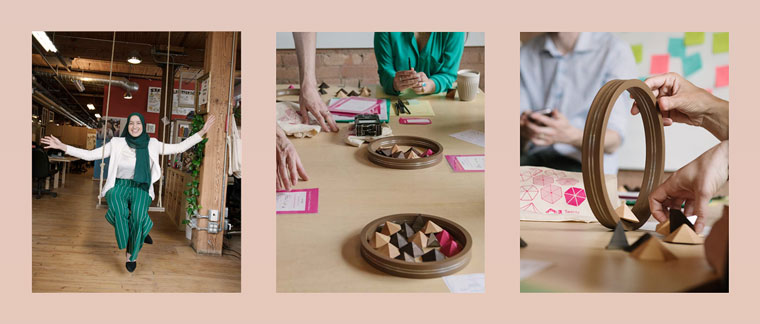“Sketch pads and lots of coffee talk are the fuel for Ilana Ben-Ari’s groundbreaking toy designs”
The Globe and Mail’s Renee Sylvestre-Williams takes us “inside the creative mind of a professional funster” in her profile of Twenty One Toys founder, Ilana Ben-Ari, and her “groundbreaking toy designs.”
Aiming to dive into the minds of “creative types across numerous disciplines and industries,” the first installment in a highly visual series called “Business of Fun” describes the environment that our CEO and lead designer has crafted, as well as the thoughtfully-designed structure of her days.
 GALIT RODIN / THE GLOBE AND MAIL
GALIT RODIN / THE GLOBE AND MAIL
Photographs of the indoor swing, affixed to the ceiling at the Centre for Social Innovation in a manner that “tempts you to sit in it,” reveal the layout of a co-working space designed to inspire collaboration amongst Ilana’s team. This openness is contrasted with the description of her private nook, ensconced in six-foot walls spattered with “reminders and business notes…crammed with books, notepads and pens in an organized chaos.”
In Sylvestre-Williams’ eyes, “this blend of the personal and the public is key to [Ilana’s] creative process, the one that brought us the Empathy and Failure toys, two puzzle-based teaching toys that emphasize play-based learning, exploring themes such as empathy and learning from failure.”
“Forget single-player mode: These are not toys you play by yourself.”
Ilana herself finds the juxtaposition fascinating because “a lot of the conversations are around collaboration and creative collaboration, and our toys are used for creative collaboration. But a big important part of collaboration also means everybody going off into their corners, and for me in particular, at a certain point in that creative process, I need to talk to everybody − and then I need to not talk to anybody.”
In describing the oscillating balance between “collaboration-versus-alone time” when designing, Ilana shares, “I’ve learned as a creator that I need a lot of time and I need to think of my time as a very, very…sacred asset. My joke is that running a business is the best way to make you stop being creative, which isn't true. Business people are some of the most creative people. I know that you are under so much stress and you are solving problems every other minute, that you can be so close to the problem and so overwhelmed that the idea of thinking ‘big picture’ is almost near impossible.”
Through compartmentalizing her time, Ilana tackles this professional puzzle, wearing her “CEO hat” Monday through Wednesday, while freeing Thursdays and Fridays for focused creative exploration.
Ilana’s interest in puzzles originated from even before her days at Carleton University spent designing what would eventually become known as “The Empathy Toy.” Forgoing Barbie dolls for more “gender-neutral toys like puzzle- and riddle-based games,” Ilana’s mother introduced her at an early age to play that “challenged [her] brain to think about building, shapes, patterns and complex riddles.” Decades later, Ilana thanks this creative process for having taught her “what works for her”, both as a creative type and an entrepreneur, asserting that, “you need to explore a lot of the wrong answers to get to what you think is the right answer.”
Read the full profile in The Globe and Mail →